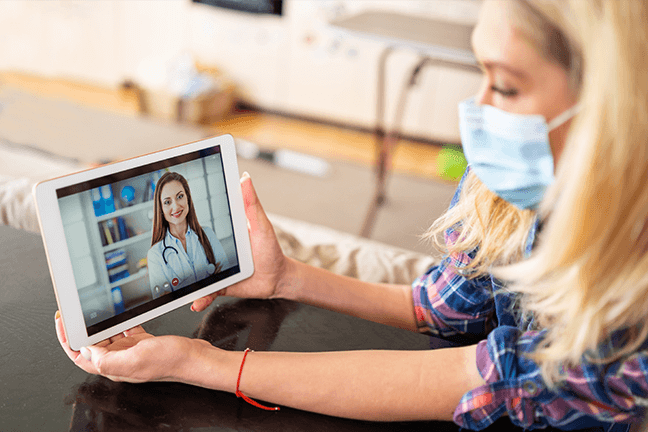Introduction
Not every place in the world has quality healthcare services and the easy availability of doctors. When mobile phones connect two-thirds of the whole world, time and distance should not hold a patient back from availing of the best quality of medical services. Remote patient monitoring uses computerized technologies to collect medical and other forms of health records or data from individuals in one location and electronically transmit that information to healthcare providers securely in a different location for evaluation and recommendations.
Healthcare web and mobile applications enable patients to send and receive reports, get prescriptions, and pay bills, without being physically present at a clinic. Through online healthcare applications and RPM (Remote Patient Monitoring) solutions, healthcare professionals can provide their services at any time and from anywhere. Patients can avail of healthcare services right from their home through their mobile phones, in spite of the distance barrier.
The remote consulting facility is a boon for the people living in regions where medical attention isn’t readily available or let’s say in a Pandemic like Corona where patients with other problems are not treated at the hospital.
COVID-19
The COVID-19 pandemic has led to a sudden loss of human life worldwide and presents an unparalleled challenge to public health, food systems, and the work-life.
According to WHO, The economic and social disruption caused by the pandemic is destructive: millions of people are at risk of falling into extreme poverty. currently estimated at nearly 41.7M, could increase by up to 132 million by the end of the year.
In the COVID-19 pandemic food, public health, and employment and labor issues, in particular workers’ health and safety, converge. Countries dealing with existing peoples who are suffering from this crisis are particularly exposed to the effects of COVID-19. Responding swiftly to the pandemic, while ensuring that to help peoples who are suffering.
Impact of COVID-19 on Remote Patient Monitoring
The remote Patient Monitoring industry was already experiencing considerable growth and development before the coronavirus pandemic, especially over the last few years, as technology has become more seamless and peoples are becoming tech-savvy.
According to the recent data, Remote Patient Monitoring is Expected to Grow at a CAGR of 8.76 % in the forecast period of 2020 to 2027 and 89% of patients are likely to accept telemedicine as a sufficient form of medical care with the factors like lack of healthcare industry professionals and unfavorable recompense policy will act as a restrain to the growth of the market.
Remote Patient Monitoring (RPM) has emerged as an essential component of healthcare during the pandemic. Although prior to the Coronavirus pandemic, many healthcare has adopted some form of RPM but achieving this at scale has been challenging.
Around 40 – 45% of Healthcare workers and doctors are providing treatment for COVID-19 infected patients and 55 – 60% of doctors are forced to leave their treatment. Social distancing and lockdowns throughout countries due to COVID-19 forced non-emergency health care providers to shut their clinics and hospitals, encouraging patients to receive treatment remotely or digitally. Due to this, A number of health care providers are modifying their business model and introducing remote patient monitoring solutions as part of their daily medical system. Remote Patient Monitoring (RPM) is no longer a secondary treatment option but a must-have option for healthcare providers, doctors, and patients.
In this global crisis, the entire healthcare system has come in an extraordinary and innovative way to overcome major barriers to deal with new challenges. Remote patient monitoring is a critical piece of Healthcare IT that will continue to develop and provide access to all and the delivery of critical data to make the best decisions to treat patients.
Remote Patient Monitoring Benefits
Reduce Emergency Situations and Readmissions
If RPM helps patients keep monitoring and measuring their body’s condition such as Blood pressure, blood sugar within range then, risks for serious and costly emergency situations, such as severe High/Low blood pressure, heart decrease and, hypoglycemia, decrease.
Reduce Burden on Healthcare Systems
With RPM, patients can get the best care without going into the hospital or clinic, since data are collected remotely, analyzes reports and responds to the data digitally reduced burden on the healthcare system. The best example is – COVID-19 situation where there is alack on hospital facilities but, RPM played an important role in this situation.
Better Quality of Care
With RPM, Healthcare providers can receive more data about blood pressure, weight, sugar level, etc. Which offers them the opportunity to provide feedback about how they are doing.
Improves Chronic Condition Management
Remote patient monitoring (RPM) can improve the management of persisting conditions with the collection and analysis of patient-generated data such as Blood pressure in hypertension, pulse in heart disease, blood glucose in diabetes.
Remote Patient Monitoring Features
E-Prescriptions
E-Prescription solutions not only reduce the error due to the improper handling of documents but also saves time with faster communication.
Consultation Summary
Consultation Summary enables you to share digital transcript details, which the patients can refer to later.
Video Conferencing
It enables virtual consultation with patients over mobile and desktops with distinct functions like screen sharing and recording.
Billing Software Solutions
The solution arrives with secure billing software that empowers you to manage your payment operations without any hassle.
Other additional features such as Downloadable PDFs, Consultation Summary, Cloud-Based solution, Workflow Management can enrich your solution. and It must be HIPAA compliant telemedicine software.
Conclusion
We must update our healthcare system as per the current situation of the market. Platforms like Telemedicine, Remote Patient monitoring, Telepharmacy are the future of the healthcare industry in the coming years. The quality and scalability of these platforms are important because the entire ecosystem of the healthcare industry would depend upon these platforms. Along with this, these solutions also come with great responsibility, therefore, Software must be built accordingly. You need a premier healthcare software development company to build this software.

